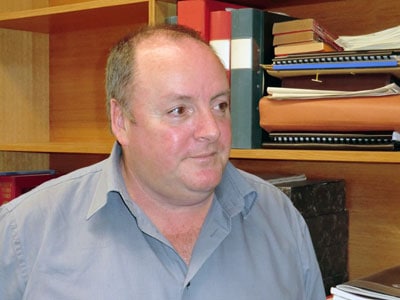
By Matin Durrani, Marsfield, Australia
There’s someone who says he’s going to be “in a grump” if the Square Kilometre Array (SKA) is not built in Australia. That’s Phil Diamond (above), head of astronomy and space science at the country’s Commonwealth Scientific and Industrial Research Organisation (CSIRO).
Diamond took up his post last year after moving from the University of Manchester in the UK, where he was director of the Jodrell Bank Centre for Astrophysics and co-ordinator of PrepSKA – the preparatory study for SKA itself.
I caught up with Diamond earlier today at CSIRO’s radiophysics laboratory at Marsfield, about 20 km north-west of Sydney, where I’m on a fact-finding tour of Australian science with three other European science journalists. The newly appointed CSIRO chief is obviously keen for SKA to be built in Australia, having upped sticks from the UK, but unfortunately the Australian plan is faced with a rival bid from various nations in southern Africa.
Both bidders are planning to construct an array of some 3000 radio-telescopes, about a third of which (in the Australian case) will be located in an area about 5 km across in the remote outback in the west of the country, with about a half distributed over another 180 km, with the final fifth spread over several thousand kilometres (including some as far away as New Zealand).
Given that the smallest object a telescope can resolve is inversely proportional to its diameter, spreading lots of dishes far apart means that SKA will have a really high “resolving power”.
And the big advantage of locating SKA in the outback is that there will be hardly any radio interference from mobile phones, power lines or other effects of modern civilization. That’s because almost no-one lives there: the shire of Murchison, where the central SKA core will be located, has a population of just 110 spread over an area that’s 20% bigger than the whole of the Netherlands. And the lack of interference is essential given that the radio emissions that SKA’s interested in are so weak that, says Diamond, it’s like having to detect the signal from an airport radar located 50 light-years away from Earth.
So the Australians think they have quite a strong case, but no doubt the Africans do too and the final decision will be made on 29 February 2012 by the international astronomy community spearheaded by the SKA project office, which is based in Diamond’s old haunt of Jodrell Bank. Not that anyone is suggesting any bias of course.
One thing both bids are having to deal with is the huge amount of information spewing out from the array – with 2 terabits of data per second from each dish, we’re talking the equivalent of a kilometre-high stack of CDs every minute. That information has to be filtered and then sent down high-performance optical cables to a central data centre.
And the point of the project? Oh, just the small matter of finding out how the first black holes and stars formed, how galaxies evolve, the nature of dark energy, the origin of cosmic magnetic fields, the nature of gravity under extreme conditions and possibly even whether we are alone in the universe.
Plus whoever wins will have the world’s astronomers knocking on their doors. So you can see why Diamond will be in a grump if it doesn’t work out for Australia.



